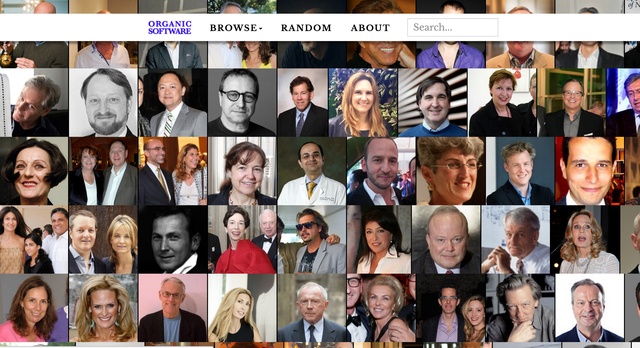Wrong Seeing, Odd Thinking, Strange Action
 http://organic.software, 2015-
http://organic.software, 2015-
I took a year’s hiatus from the art world, trying to figure some things out. I shut down the studio, stopped making saleable works, said no to shows. I didn’t stop working, though. It wasn’t a withdrawal from artmaking or a pursuit of worthier activities, it was an attempt to isolate my creative work from a confusing context so I could determine how to proceed. I made some music, I attempted to write a young adult novel, I made headway on the dumb goal of getting all my profiles and interviews and photos removed from the internet. That last one feels a little silly now, with its whiff of a ’90s-era will to integrity, and I can only explain it in terms of discomfort with the way artists are conditioned to seek visibility not only for their work but also for their persona. The contemporary mandate is to know everyone and be known by all, and thus become a maximally reproducible component. And the wind cries, “Crush it.”
Meanwhile the ice is calving: the country, the postwar order, social democracy. Thanks to years of neoliberal pessimism and Clintonite cynicism we tend to see politics as a contest over crumbs, even though there are so many of us, and the things that we need – shelter, medicine, living wages, freedom from state violence, progress toward abolition of the carceral state and the racial caste system – are both just and attainable. The good news is that Bernie Sanders, Occupy, and Black Lives Matter have showed us how to reject a bankrupt liberalism, with the result that people under 30 seem as likely to be socialists as liberals. This has a lot to do with their options in this economy, and it’s helped by social media, which has punctured the Clinton-era political spectacle traditionally abetted by the press. But social media also exacerbates the sense of futility. People on the left want to be more politically active but the forms on offer seem inadequate, so everyone spends excessive time online despite experiencing it as toxic and unproductive. Self-defeating fury is Twitter’s fuel source, from the president on down. Fury can be productive, of course. I saw Gayatri Chakravorty Spivak lecture to a majority white, upper-class audience, a member of which protested, “But now I feel like I can’t speak!” Spivak’s reply: “Be angry at the system that produces that feeling.” Unfortunately, social media is often employed to address not systemic issues but individual malfeasance. As Nico Baumbach says, “It becomes more important for people to destroy the jouissance of the other than to improve the lives of everyone.”
You can put your body into spaces of protest and solidarity, you can put your money into organizations, but what can an artwork do? Following Spivak, I tried to bend my frustration toward something productive. At the end of my hiatus I wrote a short novel, “Fuck Seth Price,” which adopted the current literary trend of autofiction. During the ensuing months of pre-publication I created a website that I saw as a companion to the novel, and both artworks were published in June of 2015. http://organic.software is an online database containing profiles of over 4000 art collectors: portraits, street views, political donations, corporate affiliations, space for user comments. I released it unauthored, with a fictionalized FAQ section that mentioned algorithms, data mining, machine learning. I was curious about anonymity today and how it channels fears and tall tales about transparency and truth, faceless actors, nameless sources, 400-pound hackers. All of which were employed to build my database.
The novel and the website were an attempt to address the art system from beyond its economic and distributive structures, but to still consider its mandate to know everyone and be known by all. I think of these works as portraits: of where my head was at, of a moment in a system (http://organic.software/faces is a class photo of the Collectors of 2015), of how myself and that system are situated within a larger framework of wealth and power. Call it a way to articulate critique of the flow while embodying the flow. Or call it hypocrisy, since taking considered distance from the market is so much easier when the market supports you.
In any case, it turns out that if you don’t sign an artwork and don’t do PR, no one gives a shit. People used the site, but not in any widespread way. Then Trump’s election made me question the value of the fake story, and I decided to put my name on the About page. It felt like a concession, because the piece had a weird power when it was inscrutable. For a year and a half, it had been quietly sitting out there doing its thing, without being Art. That’s powerful for an artist to experience. Once, when I was worrying about making “political work,” Leslie Thornton assured me that even the most abstract art can be political simply by keeping a space open. In this view subversion has no need of aim or referent, and it is true that art can be very effective when its meaning is apparently absent. On the other hand, the site is a tool, and tools should be accessible. Why keep a space open, if not for others? The site’s original About page claimed it was made by “tool developers,” and that’s true – or it’s false the way that autofiction is false – because I’ve come to see my primary role as an artist to be a maker of tools to share with other artists. Art has value as a demonstration of not simply technique or persona, but attitude and way of being. You do what you must do, and then it passes into the hands of others. Art is the productive outcome of wrong seeing, odd thinking, strange action.
